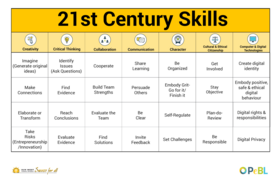Character Guidebook - Grade 10-12 (High School) Sun West
Character High School 10-12
Purpose
Why is this important?
Character is a key 21st Century skills that students need to embody in order to self-direct their learning. Having the skills and abilities to be organized, express GRIT, self-regulate, and set challenges, allows students to successful participants in the planning of their instruction and assessment. In order “to use the full potential of their minds, students must learn to filter distractions and interruptions and to think deeply and critically” (Cash, 5).
Cash, Richard M. Self-Regulation in the Classroom Helping Students Learn How to Learn: Free Spirit Publishing, 2016
Key Steps in Teaching Character Strategies
1. Isolate the skill needed to be taught.
2. Provide students with direct teaching to learn strategies and practice self-awareness.
3. Provide and allow opportunities for students to practice the skills and strategies, and reflect often. This takes time at first, but students are rewarded for their efforts once they are able to master their practiced skill.
4. Revisit strategies and skills often.
Explicit Teaching
To be able to learn and grow in 21st Century Competency understanding, it is important to teach each skill and let students experience what each skill looks like as well as how you can grow in each area. Caution: by simply saying the word "communication or collaboration...etc" students may not get a full understanding of each skill. Explicitly teaching and utilizing skills in different ways is what will ultimately promote deep understanding and growth in 21st Century Competencies.
Timeline Suggestions for Explicit Teaching
The document below provides a year plan to teach each of the 21st century skills. It is beneficial to have an explicit teaching plan to ensure each skill is taught; however skills should also be reinforced as much as possible throughout class time.
Lesson Plan Ideas
Be Organised
Part of being organizing involves understanding/breaking down tasks and planning for achievement. See below for activities and lessons.
Understanding “Executive Functioning Skills" - Explicit Teaching of Executive Functioning Skills could be required in grades 10-12. The gradual release of the transfer of responsibility should be followed (I do, We do, You do).
Steps of Executive Functioning:
- Analyze a task. Figure out what needs to be done.
- Plan how to handle the task.
- Get organized. Break down the plan into a series of steps.
- Figure out how much time is needed to carry out the plan, and set aside the time.
- Make adjustments as needed.
- Finish the task in the time allotted.
Review and model! "I do" (Ex: planning for a class period)
Practice together as a class! "We do" (Ex: organizing student binders)
Have students plan their own project! "You do" (Ex: planning for a class inquiry project)
There are many strategies to employ such as:
- Eat Way Visual Timers
- Chunking Assignments
- Writing the time on student work when you check in on them
- Graphic Organizers (see Project Planner below)
- Color code handouts
- Prioritizing Assignments (see Time Management Matrix below).

The Quadrants of Time Management
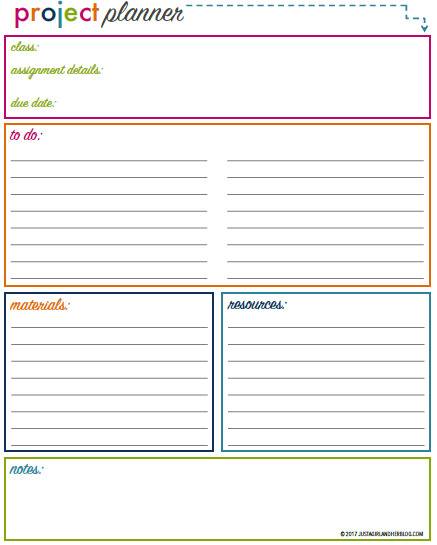
Project Planner
Additional Lesson Plans for teaching the Be Organized skill can be found on the website:
Powerpoint Presentation and Are You Organized Quiz
Embody GRIT - Go for it & Finish it!
Part of embodying GRIT involves having a growth mindset and setting SMART goals. See below for activities and lessons.
Understanding "GRIT" - Explicit teaching of GRIT could be required in grades 10-12.The gradual release of the transfer of responsibility should be followed (I do, We do, You do).
- Have students take the GRIT Test: Angela Duckworth's GRIT Test
- Conduct a class discussion about GRIT and Mindset:
- Have students create working definitions for GRIT, Growth mindset and Fixed mindset.
- Have students look up and define GRIT, Growth mindset and Fixed mindset and evaluate the working definitions with the ones they researched.
- Share videos: Carol Dweck - The Power of Yet and Angela Lee Duckworth - The Key to Success - Grit
- Have students respond to the main messages the videos.
- Have students to work through the GRIT playbook found on the Character Lab website: Character Lab
- Have students create their own way to show what they know about GRIT!
"I do" (Ex: Give GRIT test)
"We do" (Ex: Definitions)
"You do" (Ex: Show what you know!)
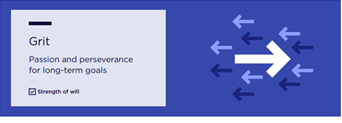
GRIT
Additional resources/ways to teach:
- Anchor Charts for classroom & on student desks – STUCK? Use SNOT Poster (see attachment below)
- Goal Setting Activities or Action Plans – SMART Template (see attachment below)
- Direct teaching of meta-cognition – Do students know how they best learn? Use Learner Profiles to support this!
Additional Lesson Plans for teaching the Embody GRIT skill can be found on the websites:
- Amy Lyon's Perseverance Walk Lesson - At the bottom of this website are links to PDFs for lesson plan and student handout!
- Amy Lyon's Setting SMART Goals - At the bottom of this website are links to PDFs for lesson plan and student handout!
Self-Regulate
Part of self-regulating is reflecting on your successes, recognizing areas of improvement, and managing your emotions. See below for activities and lessons.
Understanding Self-regulation - Explicit teaching of self-regulation could be required in grades 10-12.The gradual release of the transfer of responsibility should be followed (I do, We do, You do).
Have students complete a lesson on how to self-regulate when studying for exams.
PowerPoint:
Handout:
Direct teaching of self-regulation strategies are beneficial. Complete graphic organizers like the one below with students to get their insights on how to practice self-regulation.

Self-Regulation Graphic Organizer
Self-Reflections are wonderful tools for self-regulation.
Have students complete tracking sheets and reflections to recognize their successes and areas of growth in terms of self-regulation. Two sample sheets are below.
Off
Task Behavior Tracking sheets:

Off Task Behaviour Tracking Sheet
Weekly
reflection:
"I do" (Ex: Lesson)
"We do" (Ex: Self-Regulation Graphic Organizers)
"You do" (Ex: Reflections)
Additional Lesson Plans for teaching Self-Regulation can be found on the website:
Set Challenges
Part of setting challenges involves being a leader, and taking healthy risks. See below for activities and lessons.
Understanding how to set challenges, be a leader, and take risks involves explicit teaching in grades 10-12.The gradual release of the transfer of responsibility should be followed (I do, We do, You do).
Model setting challenges to your students - share a challenge you have set and how you
Have students research individuals that they believe embody leadership!
Additional Lesson Plans for teaching the Set Challenges skill can be found on the following websites:
Elements
of Leadership Lesson – Elements of Leadership
Leadership Activities Inspired by The Apprenticeship – Leadership Activities
Leadership Skill Building Lessons – Leadership Skill Building Lessons
Integration of Skills
Intentional integration of 21st Century Competency language in all day-to-day activities supports the development of routine reflection, skill use, and growth in support of curricular knowledge acquisition.
Why?
If we do not intentionally integrate 21st Century Competency connections into our learning environments, it is easy to forget about them. As the language becomes routine, growth in skills can and should be explored regularly. Ultimately the 21st Century Competencies are the skills needed to be successful in all day-to-day activities as well as future career opportunities. By being intentional in integrating the language and skill use in all aspects of learning, understanding of the skills can be applied and reflected upon to look for areas of potential growth and application.
How?
Once skills have been explicitly taught, integration of 21st Century Competencies can be achieved by connecting skills to all curricular areas, participating in pre-and post reflections (allowing students to predict which skills will be needed and subsequently which skills need to be worked on) and the use of 21st Century Competency rubrics to track growth.
Example: by using learner profile data, students can reflect on which skills they need to employ for a particular activity and based on this information, choose group members that have strengths or challenges in those skill areas.
Examples
When integrating 21 Century Competency language in all areas of learning consider the following curricular connected resources.
As you use similar resources in your own learning environment, how can you relate them back to growth and understanding of the 21 Century Competencies?
In ELA
This will likely be your focus area with character. Be sure to included regular lessons on the following topics, and providing ample opportunity to practice, share and reflect.
- Being organised can be demonstrated throughout ELA from the use of graphic organizers, to planning long term projects, and even formatting assignments.
- Explicitly teaching GRIT and set challenges; ELA Assess and Reflect outcomes are connected to goal setting.
- In order to complete ELA work students need to practice and employ self-regulation. Teaching students strategies on how to self-regulate is critical to their success.
In Math
Character is important in all areas of school and life, and should also be discussed, modeled and used in Math. Be sure to include the following opportunities for your students:
- Being organised aids in clarity. Teach students how to follow steps and use formulas. Students will need to show their answer clearly as well by circling or boxing their answer.
- Students should set learning goals in math and work to complete them by showing GRIT and self-regulation.
- Teach students to set challenges for themselves and to reach their potential.
Teachable moments
Whenever
a question, situation, comment or activity that involves a connection to a 21
Century Competency arises, take a moment to talk to students about it.
Discussing skills, how they integrate into everything you do in life makes the
reflection on the importance of skills a habit. This habit will instill a
growth mindset around developing skills to their fullest potential. Teachable
moments can be as short as 20 seconds. Make it your habit and it will become
theirs!
Tracking Growth
When considering 21st Century Competency application, it is essential for both the teacher and the student to track growth. There is clear potential for growth in skill use throughout our lives. To ensure growth and understanding of application is taking place, we can easily track progression using rubrics, checklists, and self-assessments.
Formative Assessment
Formative assessments of 21st Century Competencies include anecdotal documentation, self-assessments and rubric check-ins. These formative assessments provide snapshots of growth throughout the learning process and allow goal setting to take place.
See below for Self-Reflection and Goal Setting Documents:
Assessing Growth
Summative Assessment
Exemplar Rubrics
Either share the rubric with your students, or just share the categories and come up with a rubric that is personalized for your class. Post the rubric somewhere that will ensure it is referred to often.
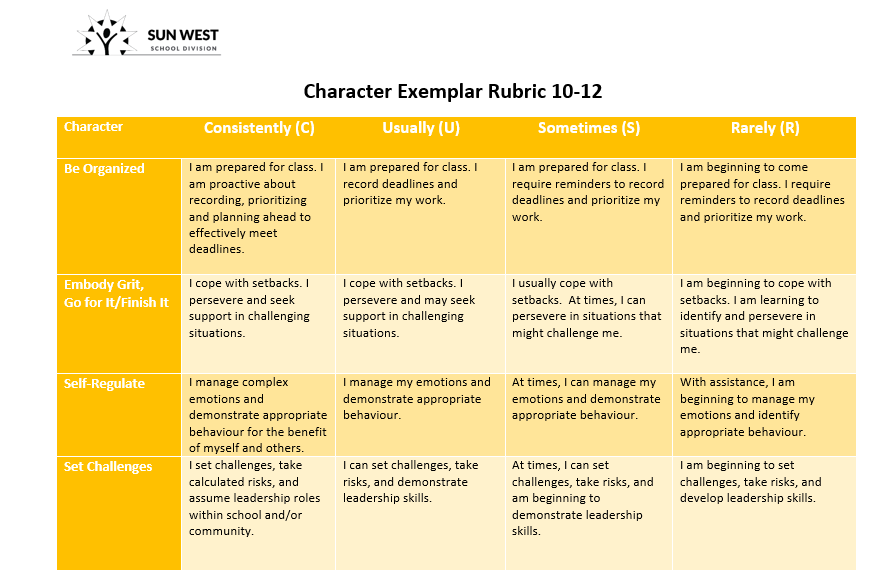
Character 10-12
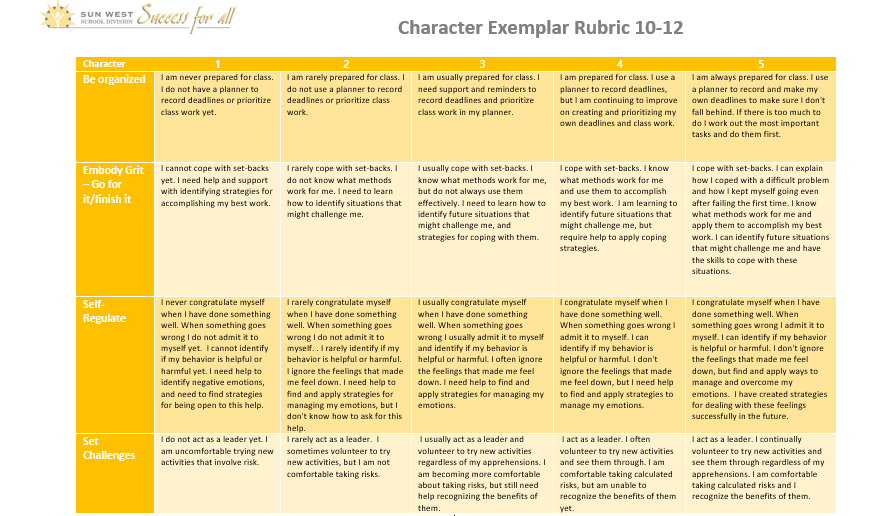
Character 10-12 Exemplar Rubric
Co-creating Rubrics
Exemplar rubrics have been developed for K-5, 6-9 and 10-12. To connect fully with students in their understanding of skill application and growth, a recommendation would be to re-write the rubric with the students to include their understanding of the skill, goals for integration in learning and commitment to the skill development.
Resources
Letitripple Resource Hub (5,000+ curated resources to help develop character year-round): http://www.letitripple.org/character-day/education-hub/
Sun West Resource Bank High School Character Resources
Print based
Sun West Original Print Based Character Guidebook: Character Guidebook
SMART Goal Worksheet:
SMART Goal Booklet – worksheets, posters, suggestions on how to use. Currently costs $5, occasionally can download for free:
Project Planner Graphic Organizer:
Stuck? Use SNOT:
Self- Regulation in the Classroom (All Sun West schools should have this resource in their library)
Videos
- Carol Dweck - The Power of Yet - Dweck's Tedx Talk about the power of the word "yet".
- Angela Lee Duckworth - The Key to Success - Grit - Duckworth's TedEd Talk about Grit.
- Don't Eat the Marshmallow TedEd Talk - Joachim de Posada's TedEd Talk about delayed gratification. Lots of replicated activities developed for classrooms.
- Brain-Based Learning Youtube - Eric Jensen's video about Brain-based Learning.
- Sara Cameron - Turn Busy into Balance - Cameron's Tedx Talk about life balance and why multi-tasking doesn't work.
Interactive
·
Educational Articles
- Working Memory Article - Self-regulation is supported by a student’s working memory. Understanding our working memory can impact how we understand why some students may struggle with some parts of self-regulation.
- SMART Goal Setting Article - SMART Goal Setting in regards to students character.
- Goals for High School Students - Ideas for student goals (includes educational, social, and emotional goals).
Web Sites
- Blissful Kids - Website teaching students about Mindfulness strategies and a simple introduction to how their brain works.
- Teaching Kids to Be Organized! - Website on the "why" of teaching students how to be organized.
- Character Lab - Website founded by Angela Duckworth with the intent to advance character development.
